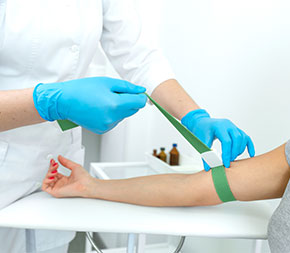The Definitive Guide for Northeast Medical Institute - New Haven Campus Phlebotomy Course & Cna Class
The Definitive Guide for Northeast Medical Institute - New Haven Campus Phlebotomy Course & Cna Class
Blog Article
See This Report on Northeast Medical Institute - New Haven Campus Phlebotomy Course & Cna Class
Table of ContentsAbout Northeast Medical Institute - New Haven Campus Phlebotomy Course & Cna ClassSome Known Details About Northeast Medical Institute - New Haven Campus Phlebotomy Course & Cna Class Rumored Buzz on Northeast Medical Institute - New Haven Campus Phlebotomy Course & Cna Class10 Simple Techniques For Northeast Medical Institute - New Haven Campus Phlebotomy Course & Cna ClassSome Ideas on Northeast Medical Institute - New Haven Campus Phlebotomy Course & Cna Class You Should KnowHow Northeast Medical Institute - New Haven Campus Phlebotomy Course & Cna Class can Save You Time, Stress, and Money.
The usage of such gadgets need to be come with by other infection prevention and control practices, and training in their usage.For settings with low sources, cost is a motoring aspect in procurement of safety-engineered gadgets. Where safety-engineered devices are not offered, competent usage of a needle and syringe is appropriate.
In the blood-sampling room for an outpatient department or facility, supply a comfy reclining couch with an arm rest.
How Northeast Medical Institute - New Haven Campus Phlebotomy Course & Cna Class can Save You Time, Stress, and Money.
Make sure that the indications for blood tasting are clearly specified, either in a created method or in documented instructions (e.g. in a research laboratory type). In all times, follow the approaches for infection prevention and control detailed in Table 2.2. Infection prevention and control methods. Accumulate all the devices required for the treatment and place it within risk-free and simple reach on a tray or cart, making sure that all the items are plainly visible.
Where the person is adult and conscious, follow the steps detailed listed below. Present on your own to the client, and ask the patient to state their full name. Check that the laboratory kind matches the individual's identification (i.e. match the person's details with the laboratory form, to make certain precise identification). Ask whether the patent has allergies, fears or has ever before collapsed during previous injections or blood attracts.
Make the individual comfy in a supine placement (preferably). Area a tidy paper or towel under the individual's arm. Review the test to be performed (see Annex F) and obtain spoken authorization. The client has a right to decline an examination at any moment prior to the blood sampling, so it is important to make certain that the patient has actually comprehended the treatment.
Fascination About Northeast Medical Institute - New Haven Campus Phlebotomy Course & Cna Class
Expand the patient's arm and evaluate the antecubital fossa or forearm. Locate a capillary of a great dimension that is visible, straight and clear. The representation in Area 2.3, shows typical placements of the vessels, however many variants are possible. The typical cubital blood vessel lies in between muscles and is normally one of the most very easy to puncture.
DO NOT place the needle where blood vessels are drawing away, due to the fact that this increases the chance of a haematoma. The blood vessel ought to show up without applying the tourniquet. check out this site Locating the capillary will help in identifying the right size of needle. Apply the tourniquet about 45 finger widths over the venepuncture website and re-examine the blood vessel.
Haemolysis, contamination and visibility of intravenous liquid and medicine can all change the results (39. Nursing staff and physicians may access central venous lines for specimens following methods. Samplings from central lines lug a threat of contamination or erroneous laboratory examination outcomes. It is acceptable, yet not ideal, to attract blood specimens when initial introducing an in-dwelling venous tool, before connecting the cannula to the intravenous liquids.
Northeast Medical Institute - New Haven Campus Phlebotomy Course & Cna Class Things To Know Before You Buy
Failure to enable sufficient get in touch with time enhances the risk of contamination. DO NOT touch the cleaned up site; in specific, DO NOT put a finger over the capillary to assist the shaft of the subjected needle.
Ask the individual to create a hand so the blood vessels are more popular. Go into the capillary quickly at a 30 level angle or much less, and proceed to present the needle along the blood vessel at the most convenient angle of access - CNA Training. When adequate blood has been collected, launch the tourniquet prior to taking out the needle
How Northeast Medical Institute - New Haven Campus Phlebotomy Course & Cna Class can Save You Time, Stress, and Money.
Withdraw the needle carefully and use gentle stress to the site with a tidy gauze or completely dry cotton-wool ball. Ask the client to hold the gauze or cotton wool in place, with the arm expanded and increased. Ask the person NOT to bend the arm, due to the fact that doing so triggers a haematoma.

8 Easy Facts About Northeast Medical Institute - New Haven Campus Phlebotomy Course & Cna Class Explained
Where feasible, maintain the tubes in a shelf and move the rack towards you - https://www.tripadvisor.in/Profile/northeastmed. If the sample tube does not have a rubber stopper, infuse exceptionally gradually right into the tube as lessening the pressure and velocity made use of to move the specimen lowers the danger of haemolysis.

Report this page